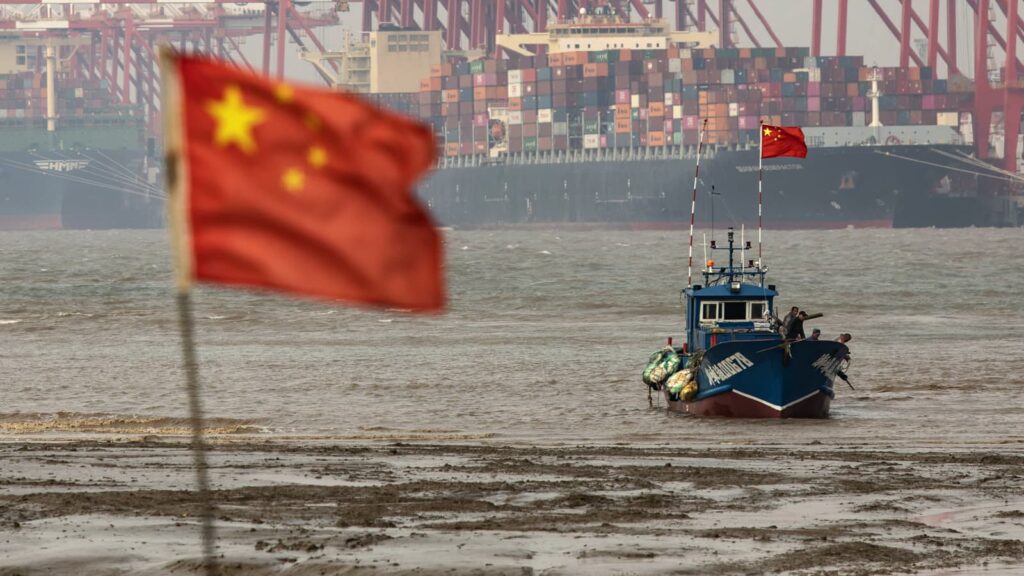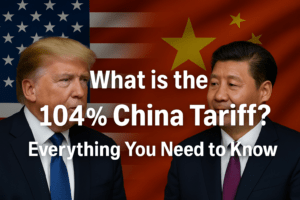Finance/ Tariffs
The U.S vs China? Tariffs for China Products raised again? 104% Tariff? Trade War? Where is it going to end? How will it affect our day-to-day life?
Introduction
The 104% China tariff has made headlines around the world, raising questions and concerns about global trade, prices, and international politics.
Whether you are a business owner, consumer, or just someone curious about what’s going on in the world, this article breaks it down in simple terms.
On April 2, 2025, U.S President Donald Trump imposed reciprocal tariffs on all countries. Among the countries, China, being at the top of the list, faced a rise of tariffs up to 67%.
Later, in response to the U.S.’s New Tariffs, China announced a change in tariffs on U.S. imports, the rise reached up to 84%.
Did it stop here? No. Due to this action taken by China, the U.S. also raised the tariff on Chinese products up to 104%. Trade War???!!
Let’s explore what the 104% China tariff is, why it was introduced, which products it affects, and how it impacts all of us.

What is the 104% China Tariff?
Tariff– In simple terms, a Tariff is a tax imposed by the government on imported products (products manufactured in other countries, coming for sale in the country).
A 104% tariff means the price of the products will become double the price, twice as expensive for importers.
So if a company wants to buy a Chinese product that costs $100, they’ll now have to pay $204 after the 104% tariff is added. That’s a huge increase.

104% Tariffs on China!!
Why Did Trump Raise Tariffs?
Trump said the rise in tariffs is to promote local industries and local manufacturing units, that is to make in their own land.
For Example, if a product that is worth $100 is imported from other countries like China will have a 104% tariff charge, so the selling cost of the product inside the U.S may increase up to $204.
Meanwhile, the locally manufactured products will not have any import tariff, and will be available in the market for just $100. So, automatically consumers will buy the products that are manufactured locally.
These types of tariffs are usually applied to protect local industries or punish unfair trade practices by other countries.

Why Did This Happen?
There are several reasons why countries, especially the United States, choose to impose such high tariffs on China:
1. Unfair Trade Practices
The local manufacturers were said to be affected, due to Chienes’ products, which have extremely low prices, and they dump products in other countries to dominate global markets. Due to this, the local manufacturers can’t compete.
2. Government Subsidies
Chinese industries like steel, solar energy, and electric vehicles (EVs) get heavy support from the Chinese government. This gives them an unfair edge over foreign competitors.
3. National Security
Some products, like tech equipment, batteries, or telecommunications devices, are seen as strategically sensitive. There are concerns about cybersecurity and over-dependence on Chinese tech.
4. Trade Deficits
The U.S. has a huge trade deficit with China, meaning it imports far more than it exports. The U.S imports more and more products from China despite its exports. Tariffs are a way to try and reduce that gap.

MADE IN CHINA!!!!
Which Products Are Affected?
The 104% tariff doesn’t apply to all Chinese goods. It mainly targets industries where Chinese products are dominating or where security concerns exist. These include:
- Electric Vehicles (EVs) and EV batteries.
- Steel and aluminum products.
- Solar panels.
- Semiconductors and electronic components.
- Tech hardware used in communications.
These are big-ticket items used by companies around the world, not just consumers.

How Does This Affect Businesses?
1. Importers
Many companies in the U.S import products from China to run their business. Now, as the tariffs are increased, the companies are facing double the prices on imports. Many are now looking for new suppliers in countries like India, Vietnam, or Mexico.
Some companies might choose to absorb the cost for a while, but eventually, they might have to raise their product prices as well.
2. Manufacturers
For local manufacturers in countries like the U.S., this can be good news. They now have a better chance to compete as Chinese imports become more expensive.

3. Chinese Companies
This is a big blow. Losing access to huge markets like the U.S. or Europe can lead to reduced production, job losses, and even factory closures in China.
What About Consumers?
These tariff changes will first affect the American consumers.
If you’re wondering how this affects your daily life, here’s how:
Prices may go up: Products like electric cars, laptops, or home appliances could become more expensive.
Fewer choices: Companies might stop selling certain items if they can’t make a profit due to high tariffs. Some companies may even need to be closed due to the loss.
Delays in supply: Finding new suppliers or manufacturers takes time, which can slow down product availability.
So even if you’re not directly involved in business, you may still feel the impact in your wallet.

The Bigger Picture: Trade War or Strategy?
This tariff is part of a broader struggle often referred to as the US-China Trade War. It’s not just about money—it’s also about power, influence, and control of future industries like green energy and AI.
China has responded to these tariffs by threatening to place its own tariffs on products from the U.S. This kind of back-and-forth can create a ripple effect across global markets.
What Could Happen Next?
The future of the 104% China tariff depends on many things:
- Diplomatic talks between China and the U.S.
- Changes in leadership or government policy.
- Global economic conditions.
How do businesses adapt to the new rules?
The adaptation for this situation may take a long time for businesses.
Since the tariffs are back and forth, every business is struggling to understand the situation.
Others think it’s a temporary move to gain leverage in negotiations.

Final Thoughts
The 104% China tariff is a dramatic step that could change the way the world trades.
While it aims to protect domestic industries and promote fair trade, it also comes with real challenges—higher prices, trade tensions, and uncertainty.
Understanding this issue helps us see the bigger picture behind the products we buy and the headlines we read.
Whether you’re a shopper, a student, or a startup founder, staying informed about such global changes can help you make smarter decisions.
Also Read About- How These Tariffs Are Affecting Global Stock Market.




